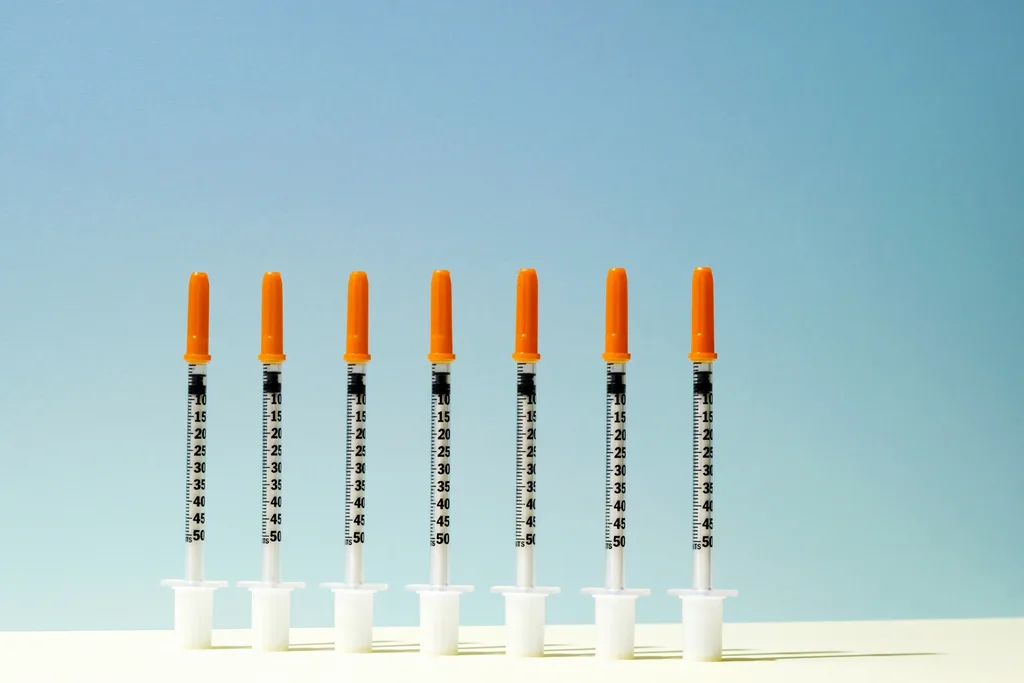Georgie Peters has just eaten lunch – a salad – and she knows what she ought to do next. Lying on her bed and fiddling with her insulin injector pen, she toys with the idea of not doing it. She’ll feel terrible if she doesn’t, but it’ll keep her skinny. She’ll still fit into that tiny summer dress. Friends will tell her she looks great and, besides, it was only a salad. She doesn’t really need that life-saving injection. Eventually, the demons in her head win and, letting the pen fall from her fingers, she resolves to do it later. Not the full dose she has been prescribed, of course – just enough to avoid a coma and hospitalisation.
For five years, Georgie, now 25, danced with the devil by restricting her vital insulin injections in an effort to lose weight. Even in the face of debilitating vision loss, potential loss of limbs and organ failure, the Melbourne teach- er struggled with a condition that is relatively unknown but prevalent across Australia and the world. Termed diabulimia, the chronic eating disorder is killing people with diabetes.
Experts estimate that between 40 per cent and 60 per cent of type 1 diabetics have experimented with restricting their insulin to lose weight. While there are no firm figures on how many young women have died from the disorder, anecdotally, the number of cases appears to be increasing, with the associated risks well documented. “Eat- ing disorders have the highest mortality rate of any mental health disorder,” confirms Dr Susan Hart, a clinical senior lecturer at The Boden Institute.
The term diabulimia is not accepted by the medical fraternity, so in Australia there is very little recognition and therefore treatment for it. As a result, there are no specialist units, few experts and no evidence-based treatment options for sufferers. As in the rest of the world, thousands of women and girls are falling through the gaps.

Georgie was a typical sufferer. Diagnosed with diabetes at 17, she was in a high-risk category for diabulimia, but it was never mentioned to her or her family. When she began taking her pre- scribed insulin, she struggled with the way her body changed. “From the start, I hated my new body,” she remembers.
“Before being diagnosed with type 1 diabetes, I had lost weight – which is typical – but then the insulin injections put it all and more back on. I was bigger and had bruises all over me as I was learning to inject and kept hitting blood vessels. My body had failed me.”
Dr Hart says Georgie’s story is one she hears regularly, as young diabetic women struggle with the dual stressors of disease management and ordinary teenage pressures. “The nature of diabetes diagnosis involves stress and anxiety,” she explains. “Couple this with weight gain – which is common at the start of insulin introduction – [as well as] an adolescent who’s potentially already body-conscious and the stars are aligning to make diabetics at an increased risk of developing an eating disorder.” To add to the cocktail of danger, diabetics are routinely advised to pay close attention to their diets, which can include counting carbs and weighing their food. It’s easy to see how this monitoring could become an obsession.
Angry and depressed, Georgie figured out early on that less insulin would lead to weight loss, but it wasn’t until she left home, away from her parents’ protective gaze, that insulin restriction became a way of life.

“Moving to London, I discovered I could function OK without much insulin,” says Georgie. “I had a job in admin, which didn’t require much energy.” For the first time, nobody was checking up on her, either, so it was easy to let things slip. “I’d take a little bit after meals and if I needed to be in a bikini, I’d cut it back even further. It made me tired, but I also looked good. Gradually I hated taking it. From a healthy weight I lost about 25 kilos in a year.”
For diabetics, insulin affects body weight in two ways. When they begin using it, it can cause an initial weight gain. Yet if they stop or skip doses, the body typically starts attacking itself. “Without insulin, the body panics and has to and another way to get energy,” explains Jacqueline Allan, director of UK organisation Diabetics with Eating Disorders. “It starts cannibalising itself, which means it burns fat and muscle tissue and eventually tissue from major organs. In some people, mostly women but increasingly a lot of men, this practice becomes chronic.”
British teen Lisa Day was diag- nosed with type 1 diabetes when she was 14. Almost immediately, she began experimenting with insulin restriction, and weight loss followed. Her family sent her to an eating disorder clinic that understood little about diabetes.
The lack of understanding of her condition meant her struggles with insulin continued on and o for the next decade. She was left with serious health problems and, tragically, passed away due to complications from her diabetes on September 12, 2015. She was just 27 years old.
“It’s just such a waste of life,” her sister, Katie Edwards, said. “If she’d had the proper care, maybe it would have turned out differently. Lisa fell through the cracks. She had a great diabetics doctor who she got on well with, but they didn’t know much about the eating disorders. She then went to an eating disorders clinic, but they didn’t know much about diabetes.

“Trying to get her the right help was like banging your head against a brick wall. There’s a massive gap in care.”
Mother-of-two Elizabeth Tomas from the US also died waiting for appropriate treatment. “No-one around our area had even heard of diabulimia,” her mother, Betty, told Marie Claire. “I was searching the internet for diabetic advice because I knew something wasn’t right.” Elizabeth spent 10 years in and out of hospital, yet no-one would, or could, do anything to help her.
“I said to her, ‘You are going to be 30, skinny and dead and I will be 50 and raising your children. That is not OK,’” Betty remembers. Betty’s awful prediction turned out to be correct. She now cares for Elizabeth’s eight-year-old daughter and five-year-old son.
“Almost four years after her death, I’m still angry,” she sighs. And echoing the frustration of a whole community, she adds: “I don’t follow the support pages anymore because young girls are still dying when they shouldn’t be.”
Dr Hart says that without better understanding of the condition, more girls and young women will lose their lives. “Insulin misuse has been recognised as a significant problem since 2005, but in Australia nothing has changed in 12 years. We need an integrated approach with experts in both eating disorders and diabetes working together, which doesn’t exist here. We could do so much better.”
“Trying to get [Lisa] the right help was like banging your head against a brick wall. There’s a massive gap in care” – Katie Edwards, sister of Lisa Day.
Like many in the same situation, Georgie’s life became a seesaw of weight loss, followed by serious health episodes. In the UK, without a GP regularly check- ing up on her, her condition was easy to hide, until a routine blood test exposed her deception. “A doctor read me the riot act,” Georgie remembers. “He said my blood sugar levels were so high I could lose limbs, have nerve damage and even go blind. I completely broke down as I’d never really thought of the consequences.”
But although the prospects were grim, it made little difference to Georgie. “In one year I’d damaged my eyes to the same level of someone who’d had diabetes for 15 or 20 years. Although I was upset, I couldn’t stop. I found it hard to take full doses. The voice in my head told me to keep [restricting] as I was too fat, even though everyone else was telling me I looked great.”
Spiralling out of control, Georgie ended up in hospital a year later, close to a potentially fatal diabetic coma. “I’d moved back to Australia and got my first teaching job,” Georgie remembers. “For years I’d been manipulating my insulin so my weight was stable or I was losing, but suddenly I was in a job where I needed to be on the top of my game. I had to take full doses of insulin to keep going and within a week the weight had piled on. I panicked and stopped taking any insulin for three full days.”

Georgie knew she was in trouble and admitted herself to hospital that week, but even then the medical system didn’t seem to see the danger she was in. “Someone told me to perk up and take my insulin. Nobody understood. It’s like telling someone who’s anorexic they just have to eat. It’s not going to happen.”
The failing system meant Georgie was sectioned in a mental health unit where she easily tricked nurses into believing she was taking insulin.
Initially eating disorder units wouldn’t accept her as she had a normal BMI and when they did, nobody was qualified to deal with her dietary needs, much less insulin use. “Once I was in, people started realising how serious it was,” Georgie says. “And I got very lucky because my dietitian worked in diabetes for five years.”
It was a hard slog for six months, and Georgie says she felt like she spent half the time educating her carers and psychologist. As a result of her treatment and determination, Georgie has been in recovery for three years. She is now a healthy weight and manages her diabetes responsibly. “My eyes have even recovered, which is incredible, and I feel good again,” she says. As part of her journey to wellness, she hopes to help other young women suffering from the condition. Along with fellow diabetes advocate Lisa Ingle, she’s formed a support group called Diabetes & Eating Disorders Awareness (DEDA).
“It sometimes feels like we’re fighting a losing battle,” Lisa says. “It’s frustrating at times, but each person who finds us discovers they are not alone; that provides hope. It’s why we’re here and why we keep going.”
For help in Australia and New Zealand visit deda.org.nz. The first international conference on diabetes and eating disorders will take place in New Orleans on November 9-11, 2018.










